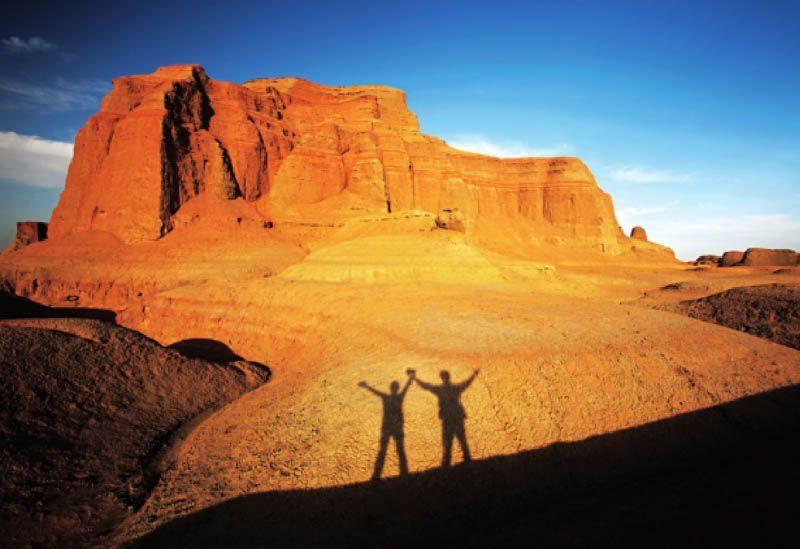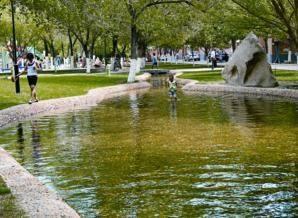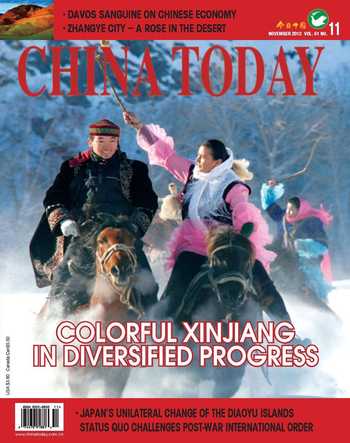A Smart Oilfield City and People-friendly Oasis



IN 1955, 22-year-old Wang Yanming left his hometown in Hebei Province for Karamay in Chinas far west. As an oil worker, Wang witnessed over the next half-century Karamays development from a distant Gobi desert outpost to a modern city.
Karamay in the Uygur language means black oil. It is site of the first large-scale oilfield discovered after the founding of the Peoples Republic of China. Wang Yanming and his contemporaries are both founders and residents of the city. Karamay witnessed their youth and enthusiasm, and carries their expectations for the future. This resource-based city is now exploring appropriate modes of transformation.
World-class Oil City
Many of Chinas 118 so-called resourcebased cities face serious problems, such as an over-simplified pillar industry, irrational industrial structure, excessive energy consumption per unit of GDP, heavy pollution, and over-dependence on resources. Forty-four of them are classified as resource-depleted cities.
Aware of a looming crisis, Karamay is proactively seeking solutions. “Rather than await doom, we are much better-advised to take advantage of our oil and gas production to initiate industrial restructuring,” Mayor Chen Xinfa of Karamay said.
As a typical resource-based city, oil is the pivot of all Karamays economic activities. For years the local government redirected its attention to the tertiary industry, but it has accomplished no more than 10 percent of the citys GDP. The oil and petrochemical industries are still predominant, accounting for the lions share of 90 percent. The government has hence put forward a new strategy based on the information industry to make Karamay a “world-class oil city.”
Karamay is at the center of the pan-Central Asia oil-gas enrichment zone that includes West-ern China, Central Asia, West Asia, South Asia and Russian Siberia. It accommodates 80 percent of the worlds oil reserves, and is expected to be a main area of future oil exploitation. As an oil city, Karamay has a robust petroleum industry. It also commands a complete industrial chain, first-class technological services to provide to other countries, and the best skilled workers. All these advantages contribute to its potential as an internationally competitive oil city.
To bring this strategy into effect, Karamay has accelerated construction of six related industries – oil and gas production, refining and chemicals, technological services, machinery manufacture, oil storage, and engineering education. Special attention has also been paid to developing the three new industries of finance, information and tourism. These measures have extended the industrial chain to downstream sectors, thus im- proving the economic structure and enhancing its risk-resisting capacity.
The new strategy attracted investment to Karamay last year from several large companies. Shanghaibased new material company Genius invested RMB 10.8 billion in the new petrochemical material integration project. Shanghai Yingde Gases Group Co., Ltd. invested RMB 10.3 billion in an air separation and industrial fuel gas project. And Jiangsu Baoli Asphalt Co. Ltd. financed a modified asphalt cement project.
Information technology is at the core of industrial upgrading, and has improved the quality and efficiency of production. Screens in the information system monitoring office at the Xinjiang Oilfield Company show the operation process of oilfields 400-500 kilometers away, along with information and data on production, research, administration and management. Karamay is going all out to make the transition from a digital to a smart oilfield that features automatic sensors and controls, trend predictions and decision optimization. The smart oilfield is expected to take shape in 2020.
Karamay will thus spark diversification in the citys economy away from sole reliance on exploiting oil and gas resources in the Junggar Basin. It is advancing along the track of sustainable development by providing technological services to the worlds oil-gas enrichment zones and even bigger markets.
People-friendly Environment
Completely in favor of the citys new strategy, Wang Yanming decided to contribute to it. Before retiring, he was secretary of the CPC committee of the Second Oil Extraction Plant. Upon retirement, he set about planting trees around the factory, with the support of his former colleagues and workers.
Growing trees in the desert is no easy task. Wang had to start by improving the soil and experimenting with various tree species. After 20 years of hard work, greenery now covers around 6.67 hectares of wasteland and desert. It includes 10,000 poplars and elms that have formed windbreaks, and 3,000 fruit-bearing trees. The orchard, named “Yanming Garden,” has become an activity base for teenagers.
Now in his 80s, Wang takes a daily stroll around the garden. As his brainchild, it has become a part of his life.
Karamay residents set great store by the citys green areas. Surrounded by desert, the city is subject to hot, dry weather, and consequently water shortages and scant vegetation. Matters took a turn for the better in 2000 with the completion of a water diversion project. In 2008, green areas accounted for 38.65 percent of the citys territory, and the per capita public green area increased to 12.2 square meters from 2 square meters in 1999. This has dramatically improved the urban landscape and living environment. In 2010 Karamay set itself the goal of building an environment-friendly and resourceconserving city.
Senior daycare centers are an essential part of building a livable city. At the Golden Age Senior Daycare Center, 77-year-old Guo Kongliang and his companions daily meet and play their various musical instruments. A native of Hubei Province, Guo was also among the first group that came to Karamay in the early 1950s. As his children live and work on distant oilfields, he and his wife spend most of their time with their contemporaries at the center. They take a cab there each morning and go home after supper. The expenses entailed account for only a third of Guos monthly retirement pension of 4,600 yuan. The Golden Age provides good food, the chance to take part in various activities, and fundamental medical treatment should anyone be taken ill. About 130 seniors come to the center each day.
“Many of these seniors are the pioneers, founders and heroes of the city, but as their children are usually busy working they cant keep them company that often,” head of the Golden Age Senior Daycare Center Liu Hongyan explained. “This is why the center is such an important place for seniors and a key feature of the governments socialized home-based care for the elderly. We now have 24 daycare centers in the city, and the planned number is 43.”
“In a resource-based city undergoing transformation, livelihoods should be our priority,” said Mayor Chen Xinfa. “Our city has a promising future as long as we can attract talented people to work and live here.”
Current livelihood projects, like tree planting, senior daycare centers, community health care, and food safety cooperatives have created a livable environment. Karamay has also become the preferred choice of college graduates, even overseas students. All have undoubtedly pumped new blood into efforts towards sustained prosperity.
A Future of Diversity
Wang Yanmings garden has been quite lively recently. It receives regular visits from his former colleagues and neighbors, and also growing numbers of tourists. Travelers flocking to Karamay have given rise to family inns and budget hostels – 51 in total – offering board and lodging. In recent years Karamay has been awarded “national model city of environmental protection,” “national civilized city,” and “the habitat environment prize.” These awards testify to the improvements in its environment, and have drawn even more tourists.
Karamay is a unique mixture of natural scenery and industrial civilization. It is a modern city in the Gobi desert where oil exploitation structures stand out amid a vast oilfield, yet also site of the Baiyang River Grand Canyon, Ailik Lake, and the Yardang landforms.
Tourism has become Karamays most vibrant industry. In the first half of this year it received over a million tourists, an increase of 51 percent over the same period last year, and tourism income hit RMB 583 million, a year-on-year increase of 46 percent.
Karamay attracted several cultural and tourism projects at the First China-Eurasia Expo in May 2011. They include the City of Fame of World Elites, with an investment of RMB 20 billion, a theme park and holiday resort with an investment of RMB 6 billion, and a cultural creative zone with an investment of RMB 4 billion. Developing the tourism market is an appropriate path for Karamays transformation from a singleproduct economy to diversified economies.

